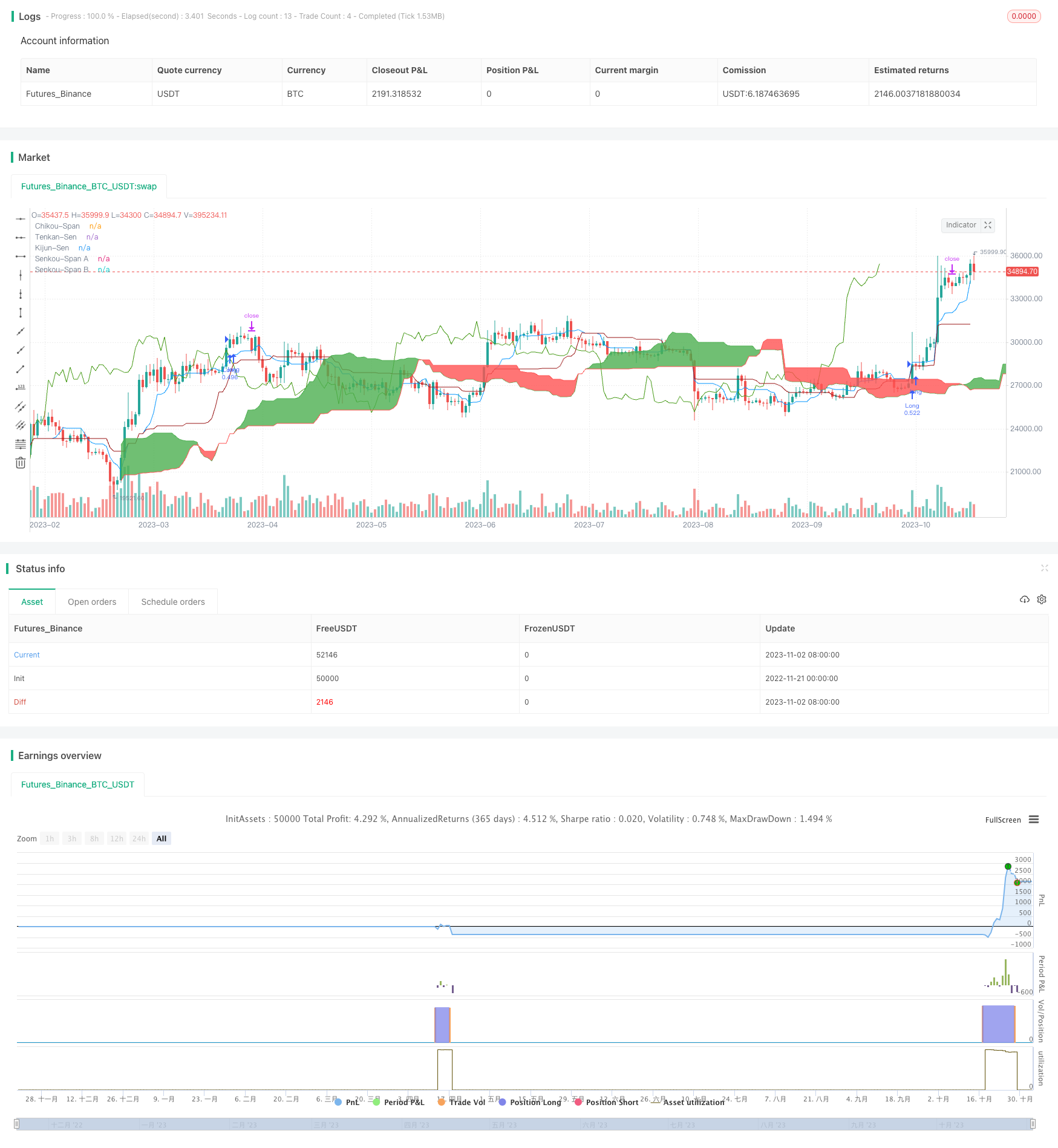
概述
Ichimoku Cloud and MACD Momentum Riding是一个结合Ichimoku云图指标和MACD动量指标的趋势跟踪策略。该策略利用Ichimoku云图判断趋势方向和支持与阻力位,以及MACD指标判断动量反转,在趋势中择时进入场内。同时,策略采用追踪止损来锁定利润,降低回撤。
策略原理
Ichimoku云图
Ichimoku云图由转向线(Tenkan-Sen)、基准线(Kijun-Sen)、先行线(Senkou-Span A)、延迟线(Senkou-Span B)和确认线(Chikou-Span)组成。该策略使用以下信号来判断趋势方向和支持阻力:
- 价格在云图上方,为上升趋势
- 价格在云图下方,为下降趋势
- 转向线上穿基准线,为多头信号
- 转向线下穿基准线,为空头信号
MACD指标
Moving Average Convergence Divergence,即MACD,是一种动量指标。该策略中MACD的快线上穿慢线为做多信号,下穿为做空信号。
入场与退出
当转向线上穿基准线,延迟线上穿前26根K线的收盘价,收盘价突破云图上沿,且MACD金叉时,做多入场。
当价格上涨3%时,策略会移动止损线至当前价格的97%,以锁定利润并跟踪价格上涨。如果回撤超过3%,则止损退出。
当转向线下穿基准线,延迟线下穿前26根K线的收盘价,收盘价跌破云图下沿,且MACD死叉时,做空入场。
当价格下跌3%时,策略会移动止损线至当前价格的103%,以锁定利润并跟踪价格下跌。如果回升超过3%,则止损退出。
优势分析
这种策略结合趋势判断和入场时机把握,可以在趋势行情中获得较好收益。
Ichimoku云图可以清楚判断趋势方向。策略只在云图方向一致时入场,避免逆势操作。
MACD可有效判断短期动量反转。结合云图判断,可提高入场精准度。
追踪止损使得策略可在趋势中长期运行。策略可配合资金管理有效控制单笔交易风险。
风险分析
该策略也存在一定风险:
云图生成需要较长数据周期,在短期内判断可能不准。
MACD作为随价格波动的指标,容易产生误信号。应结合更多指标修正判断。
追踪止损只适合趋势行情,应适当调整止损幅度。否则在震荡行情中可能过于频繁止损。
策略本身并无风控模块,用户应配合资金管理来控制亏损。
优化方向
关于Ichimoku Cloud and MACD Momentum Riding策略,可从以下几个方向进行优化:
优化参数,调整转向线、基准线等的周期参数,优化MACD的参数,使信号更明确。
增加过滤条件,结合RSI、布林带等其他指标来验证信号,减少误判率。
增加动态止损,根据市场波动程度和风险偏好动态调整止损幅度。
结合资金管理,限制单笔损失占比,有效控制总体亏损。
开发自动选择合约、调仓的功能。扩大策略适应性,在更多市场中运用。
总结
Ichimoku Cloud and MACD Momentum Riding策略是一个既考虑趋势判断又兼顾交易信号的量化策略。在unfinished参数优化和风控措施的配合下,该策略可以获得较好的策略收益率。它适合有一定量化和编程基础的投资人作为趋势跟踪策略使用,也为量化初学者提供了一个参考实例来学习指标结合和策略开发。
/*backtest
start: 2022-11-21 00:00:00
end: 2023-11-03 05:20:00
period: 1d
basePeriod: 1h
exchanges: [{"eid":"Futures_Binance","currency":"BTC_USDT"}]
*/
//@version=5
strategy('Ichimoku Cloud with MACD and Trailing Stop Loss',
overlay=true,
initial_capital=1000,
process_orders_on_close=true,
default_qty_type=strategy.percent_of_equity,
default_qty_value=30,
commission_type=strategy.commission.percent,
commission_value=0.1)
showDate = input(defval=true, title='Show Date Range')
timePeriod = time >= timestamp(syminfo.timezone, 2022, 6, 1, 0, 0)
// Inputs
ts_bars = input.int(9, minval=1, title='Tenkan-Sen Bars')
ks_bars = input.int(26, minval=1, title='Kijun-Sen Bars')
ssb_bars = input.int(52, minval=1, title='Senkou-Span B Bars')
cs_offset = input.int(26, minval=1, title='Chikou-Span Offset')
ss_offset = input.int(26, minval=1, title='Senkou-Span Offset')
long_entry = input(true, title='Long Entry')
short_entry = input(true, title='Short Entry')
middle(len) => math.avg(ta.lowest(len), ta.highest(len))
// Ichimoku Components
tenkan = middle(ts_bars)
kijun = middle(ks_bars)
senkouA = math.avg(tenkan, kijun)
senkouB = middle(ssb_bars)
// Plot Ichimoku Kinko Hyo
plot(tenkan, color=color.new(#0496ff, 0), title='Tenkan-Sen')
plot(kijun, color=color.new(#991515, 0), title='Kijun-Sen')
plot(close, offset=-cs_offset + 1, color=color.new(#459915, 0), title='Chikou-Span')
sa = plot(senkouA, offset=ss_offset - 1, color=color.new(color.green, 0), title='Senkou-Span A')
sb = plot(senkouB, offset=ss_offset - 1, color=color.new(color.red, 0), title='Senkou-Span B')
fill(sa, sb, color=senkouA > senkouB ? color.green : color.red, title='Cloud color', transp=90)
ss_high = math.max(senkouA[ss_offset - 1], senkouB[ss_offset - 1])
ss_low = math.min(senkouA[ss_offset - 1], senkouB[ss_offset - 1])
// MACD
[macd, macd_signal, macd_histogram] = ta.macd(close, 12, 26, 9)
// Entry/Exit Signals
tk_cross_bull = tenkan > kijun
tk_cross_bear = tenkan < kijun
cs_cross_bull = ta.mom(close, cs_offset - 1) > 0
cs_cross_bear = ta.mom(close, cs_offset - 1) < 0
price_above_kumo = close > ss_high
price_below_kumo = close < ss_low
bullish = tk_cross_bull and cs_cross_bull and price_above_kumo and ta.crossover(macd, macd_signal)
bearish = tk_cross_bear and cs_cross_bear and price_below_kumo and ta.crossunder(macd, macd_signal)
// Configure trail stop level with input options
longTrailPerc = input.float(title='Trail Long Loss (%)', minval=0.0, step=0.1, defval=3) * 0.01
shortTrailPerc = input.float(title='Trail Short Loss (%)', minval=0.0, step=0.1, defval=3) * 0.01
// Determine trail stop loss prices
longStopPrice = 0.0
shortStopPrice = 0.0
longStopPrice := if strategy.position_size > 0
stopValue = close * (1 - longTrailPerc)
math.max(stopValue, longStopPrice[1])
else
0
shortStopPrice := if strategy.position_size < 0
stopValue = close * (1 + shortTrailPerc)
math.min(stopValue, shortStopPrice[1])
else
999999
strategy.entry('Long', strategy.long, when=bullish and long_entry and timePeriod)
strategy.exit('Exit', stop = longStopPrice, limit = shortStopPrice)
//strategy.close('Long', when=bearish and not short_entry)
//strategy.entry('Short', strategy.short, when=bearish and short_entry and timePeriod)
//strategy.close('Short', when=bullish and not long_entry)